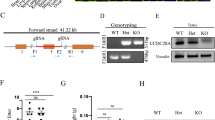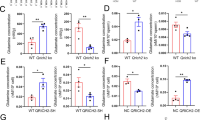Abstract
Uroplakins (UPKs) form physical and chemical barriers in the bladder and other urinary tract tissues. We previously reported the identification and localization of UPKs in the male reproductive tract of rat. In this study, we characterized Upk1a knockout mice and report a marginal reduction in fecundity associated with significant decrease in sperm count. Upk1a mice had lower bacterial clearance capacity when challenged with uropathogenic Escherichia coli for 1 to 5 days. High-throughput analyses of testicular transcriptome indicated that 1128 genes that are expressed in testis of wild-type mice were completely absent in the knockout, while 2330 genes were found to be expressed only in the testis of knockout mice. Furthermore, differential regulation of 148 (67 upregulated and 81 downregulated) was observed. Gene ontology analyses indicated that processes related to integral components of membrane (plasma membrane), G-protein receptor activity and signaling, olfactory receptor activity and perception of smell, organization of extracellular space/region, immune and inflammatory responses to pathogens, spermatid development, meiotic cell cycle, and formation of synaptonemal complex were affected. Results of this study provide evidence on the possible multi-functional role of Upk1a in male reproductive tract and in other tissues as well.








Similar content being viewed by others
Data Availability
All relevant data is available in the manuscript.
Code Availability
Not applicable.
Abbreviations
- UPKs:
-
Uroplakins
- UPEC:
-
Uropathogenic E. coli
- RT-PCR:
-
Reverse transcriptase polymerase chain reaction
- DAVID:
-
Database for Annotation, Visualization and Integrated Discovery
- PBS:
-
Phosphate-buffered saline
- STAR:
-
Spliced Transcripts Alignment to a Reference
References
Desalle R, Chicote JU, Sun TT, Garcia-Espana A. Generation of divergent uroplakin tetraspanins and their partners during vertebrate evolution: identification of novel uroplakins. BMC Evol Biol. 2014;14:13.
Garcia-Espana A, Chung PJ, Zhao X, Lee A, Pellicer A, Yu J, et al. Origin of the tetraspanin uroplakins and their co-evolution with associated proteins: implications for uroplakin structure and function. Mol Phylogenet Evol. 2006;41:355–67.
Wu XR, Lin JH, Walz T, Haner M, Yu J, Aebi U, et al. Mammalian uroplakins. A group of highly conserved urothelial differentiation-related membrane proteins. J Biol Chem. 1994;269:13716–24.
Hu CC, Liang FX, Zhou G, Tu L, Tang CH, Zhou J, et al. Assembly of urothelial plaques: tetraspanin function in membrane protein trafficking. Mol Biol Cell. 2005;16:3937–50.
Tu L, Kong XP, Sun TT, Kreibich G. Integrity of all four transmembrane domains of the tetraspanin uroplakin Ib is required for its exit from the ER. J Cell Sci. 2006;119:5077–86.
Tu L, Sun TT, Kreibich G. Specific heterodimer formation is a prerequisite for uroplakins to exit from the endoplasmic reticulum. Mol Biol Cell. 2002;13:4221–30.
Szymańska B, Matuszewski M, Dembowski J, Piwowar A. Initial evaluation of uroplakins UPIIIa and UPII in selected benign urological diseases. Biomolecules. 2021;11:1816.
Zhu J, Lu Q, Li B, Li H, Wu C, Li C, et al. Potential of the cell-free blood-based biomarker uroplakin 2 RNA to detect recurrence after surgical resection of lung adenocarcinoma. Oncol Lett. 2021;22:520.
Leivo MZ, Tacha DE, Hansel DE. Expression of uroplakin II and GATA-3 in bladder cancer mimickers: caveats in the use of a limited panel to determine cell of origin in bladder lesions. Hum Pathol. 2021;113:28–33.
Byun Y, Choi YC, Jeong Y, Yoon J, Baek K. Long noncoding RNA expression profiling reveals upregulation of uroplakin 1A and uroplakin 1A antisense RNA 1 under hypoxic conditions in lung cancer cells. Mol Cells. 2020;43:975–88.
Song Y, Wang H, Zou XJ, Zhang YX, Guo ZQ, Liu L, et al. Reciprocal regulation of HIF-1α and uroplakin 1A promotes glycolysis and proliferation in hepatocellular carcinoma. J Cancer. 2020;11:6737–47.
Zhu Z, Xu J, Li L, Ye W, Chen B, Zeng J, et al. Comprehensive analysis reveals CTHRC1, SERPINE1, VCAN and UPK1B as the novel prognostic markers in gastric cancer. Translational cancer research. 2020;9:4093–110.
Sakakibara K, Sato K, Yoshino K, Oshiro N, Hirahara S, Mahbub Hasan AK, et al. Molecular identification and characterization of Xenopus egg uroplakin III, an egg raft-associated transmembrane protein that is tyrosine-phosphorylated upon fertilization. J Biol Chem. 2005;280:15029–37.
Hasan AK, Fukami Y, Sato K. Gamete membrane microdomains and their associated molecules in fertilization signaling. Mol Reprod Dev. 2011;78:814–30.
Mahbub Hasan AK, Sato K, Sakakibara K, Ou Z, Iwasaki T, Ueda Y, et al. Uroplakin III, a novel Src substrate in Xenopus egg rafts, is a target for sperm protease essential for fertilization. Dev Biol. 2005;286:483–92.
Kuriyama S, Tamiya Y, Tanaka M. Spatiotemporal expression of UPK3B and its promoter activity during embryogenesis and spermatogenesis. Histochem Cell Biol. 2017;147:17–26.
Liao Y, Chang HC, Liang FX, Chung PJ, Wei Y, Nguyen TP, et al Uroplakins play conserved roles in egg fertilization and acquired additional urothelial functions during mammalian divergence. Mol Biol Cell. 2018:mbcE18080496.
Sato KI, Tokmakov AA. Membrane microdomains as platform to study membrane-associated events during oogenesis, meiotic maturation, and fertilization in Xenopus laevis. Methods Mol Biol. 2019;1920:59–73.
Babu Munipalli S, Yenugu S. Uroplakin expression in the male reproductive tract of rat. Gen Comp Endocrinol. 2019;281:153–63.
Wu XR, Kong XP, Pellicer A, Kreibich G, Sun TT. Uroplakins in urothelial biology, function, and disease. Kidney Int. 2009;75:1153–65.
Wu XR, Sun TT, Medina JJ. In vitro binding of type 1-fimbriated Escherichia coli to uroplakins Ia and Ib: relation to urinary tract infections. Proc Natl Acad Sci USA. 1996;93:9630–5.
Mulvey MA, Lopez-Boado YS, Wilson CL, Roth R, Parks WC, Heuser J, et al. Induction and evasion of host defenses by type 1-piliated uropathogenic Escherichia coli. Science. 1998;282:1494–7.
Martinez JJ, Mulvey MA, Schilling JD, Pinkner JS, Hultgren SJ. Type 1 pilus-mediated bacterial invasion of bladder epithelial cells. EMBO J. 2000;19:2803–12.
Rajesh A, Yenugu S. Effect of immunization against prostate- and testis-expressed (PATE) proteins on sperm function and fecundity in the rat. J Reprod Immunol. 2015;110:117–29.
Rajesh A, Yenugu S. shRNA mediated ablation of prostate and testis expressed (Pate) messenger RNA results in impaired sperm function and fertility. Andrology. 2017;5:541–7.
Bou Khalil M, Chakrabandhu K, Xu H, Weerachatyanukul W, Buhr M, Berger T, et al. Sperm capacitation induces an increase in lipid rafts having zona pellucida binding ability and containing sulfogalactosylglycerolipid. Dev Biol. 2006;290:220–35.
KN G-C, Ak O, DK M. Principles for valid histopathologic scoring in research. Vet Pathol. 2013;50:1007–15.
R K. Multiparametric and semi-quantitative scoring systems for the evaluation of mouse modelhistopathology—A systematic review. BMC Vet Res. 2013;9:123.
de BrandineSena G, Smith AD. Falco: high-speed FastQC emulation for quality control of sequencing data. F1000Research. 2019;8:1874.
Chen S, Zhou Y, Chen Y, Gu J. fastp: an ultra-fast all-in-one FASTQ preprocessor. Bioinformatics. 2018;34:i884–90.
Dobin A, Davis CA, Schlesinger F, Drenkow J, Zaleski C, Jha S, et al. STAR: ultrafast universal RNA-seq aligner. Bioinformatics. 2013;29:15–21.
Liao Y, Smyth GK, Shi W. featureCounts: an efficient general purpose program for assigning sequence reads to genomic features. Bioinformatics. 2014;30:923–30.
Love MI, Huber W, Anders S. Moderated estimation of fold change and dispersion for RNA-seq data with DESeq2. Genome Biol. 2014;15:550.
Aboushwareb T, Zhou G, Deng FM, Turner C, Andersson KE, Tar M, et al. Alterations in bladder function associated with urothelial defects in uroplakin II and IIIa knockout mice. Neurourol Urodyn. 2009;28:1028–33.
Hu P, Deng FM, Liang FX, Hu CM, Auerbach AB, Shapiro E, et al. Ablation of uroplakin III gene results in small urothelial plaques, urothelial leakage, and vesicoureteral reflux. J Cell Biol. 2000;151:961–72.
Carpenter AR, Becknell MB, Ching CB, Cuaresma EJ, Chen X, Hains DS, et al. Uroplakin 1b is critical in urinary tract development and urothelial differentiation and homeostasis. Kidney Int. 2016;89:612–24.
Liao Y, Chang HC, Liang FX, Chung PJ, Wei Y, Nguyen TP, et al. Uroplakins play conserved roles in egg fertilization and acquired additional urothelial functions during mammalian divergence. Mol Biol Cell. 2018;29:3128–43.
Matuszewski MA, Tupikowski K, Dołowy Ł, Szymańska B, Dembowski J, Zdrojowy R. Uroplakins and their potential applications in urology. Cent European J Urol. 2016;69:252–7.
Zwaans BMM, Carabulea AL, Bartolone SN, Ward EP, Chancellor MB, Lamb LE. Voiding defects in acute radiation cystitis driven by urothelial barrier defect through loss of E-cadherin, ZO-1 and Uroplakin III. Sci Rep. 2021;11:19277.
Jackson AR, Li B, Cohen SH, Ching CB, McHugh KM, Becknell B. The uroplakin plaque promotes renal structural integrity during congenital and acquired urinary tract obstruction. Am J Physiol Renal Physiol. 2018;315:F1019–31.
Finlay JB, Liu X, Ermel RW, Adamson TW. Maternal weight gain as a predictor of litter size in Swiss Webster, C57BL/6J, and BALB/cJ mice. J Am Assoc Lab Anim Sci. 2015;54:694–9.
Thumbikat P, Berry RE, Schaeffer AJ, Klumpp DJ. Differentiation-induced uroplakin III expression promotes urothelial cell death in response to uropathogenic E. coli. Microbes Infect. 2009;11:57–65.
Thumbikat P, Berry RE, Zhou G, Billips BK, Yaggie RE, Zaichuk T, et al. Bacteria-induced uroplakin signaling mediates bladder response to infection. PLoS Pathog. 2009;5:e1000415.
Muñoz-Carrillo JL, et al. Cytokine profiling plays a crucial role in activating immune system to clear infectious pathogens. In: Tyagi RK, Bisen PS, editors. Immune response activation and immunomodulation. London: IntechOpen; 2018. https://doi.org/10.5772/intechopen.80843.
Ali MA, Wang Y, Qin Z, Yuan X, Zhang Y, Zeng C. Odorant and taste receptors in sperm chemotaxis and cryopreservation: roles and implications in sperm capacitation, motility and fertility. Genes (Basel). 2021;12:488.
Wu SY, Jiang YH, Jhang JF, Hsu YH, Ho HC, Kuo HC. Inflammation and barrier function deficits in the bladder urothelium of patients with chronic spinal cord injury and recurrent urinary tract infections. Biomedicines. 2022;10:220.
Chen X, Li Y, Dai H, Zhang H, Wan D, Zhou X, et al. Cyclin-dependent kinase 7 is essential for spermatogenesis by regulating retinoic acid signaling pathways and the STAT3 molecular pathway. IUBMB Life. 2021;73:1446–59.
Acknowledgements
We thank the facilities extended by UGC-SAP, UGC-CAS, DBT-CREBB, DST-PURSE, UGC-UPE-II, FIST and IoE programmes at School of Life Sciences, University of Hyderabad. SBM received the junior and senior research fellowship from Department of Biotechnology, Government of India. We thank Dr Aurelie Jory (Lily) and the BLiSC Mouse Genome Engineering Facility, National Centre for Biological Sciences, Bangalore, India, for generating the knockout mice.
Author information
Authors and Affiliations
Contributions
SBM carried out the experimental work. SY conceptualized the ideas, wrote the manuscript and provided the reagents and other facilities.
Corresponding author
Ethics declarations
Ethics Approval
All procedures involving animals were conducted using the guidelines for the care and use of laboratory animals and this study was specifically approved by the Institutional Animal Ethics Committee of University of Hyderabad (UH/IAEC/SY/2021–1/20).
Consent to Participate
Not applicable.
Consent for Publication
All the authors have read the manuscript and consent to publish.
Competing Interests
The authors have no conflicts or competing interests to declare.
Supplementary Information
Below is the link to the electronic supplementary material.
Rights and permissions
Springer Nature or its licensor holds exclusive rights to this article under a publishing agreement with the author(s) or other rightsholder(s); author self-archiving of the accepted manuscript version of this article is solely governed by the terms of such publishing agreement and applicable law.
About this article
Cite this article
Munipalli, S.B., Yenugu, S. Uroplakin 1a Knockout Mice Display Marginal Reduction in Fecundity, Decreased Bacterial Clearance Capacity, and Drastic Changes in the Testicular Transcriptome. Reprod. Sci. 30, 914–927 (2023). https://doi.org/10.1007/s43032-022-01057-z
Received:
Accepted:
Published:
Issue Date:
DOI: https://doi.org/10.1007/s43032-022-01057-z




